
Border Collie Rescue - On Line - Universal Commands

Universal Commands
Visual commands for deaf dogs and for controlling dogs at a distance
In Border Collie Rescue all verbal commands used are accompanied by hand signals which serve
to emphasise and compliment the instruction.
This is of great benefit when training deaf dogs, but is also useful if a hearing dog is some distance away or conditions are such that the sound of verbal commands is drowned out by other background noises.
There is no mystery or weird science involved in training hand signals. Most dog owners will probably have unknowingly trained their dog to respond to sign simply because they use particular gestures or facial expressions with certain commands.
Even over some distance, a dog is able to differentiate small variations in signals, such as if the finger is extended or the palm of the hand facing up or down, the arm fully extended or the elbow bent.
Border Collies are known to be very intelligent, so it is important to be very consistent in the use of any command, verbal or sign.
Even a small deviation may cause the dog to think it is getting a different command from the one intended.
This is why the Border Collie is a satisfying breed to train and interact with if the handler is good and consistent, but difficult to train if the handler lacks discipline or is lazy in their approach to training.
The following commands are intended to convey a brief instruction to pet dogs. In Border Collie Rescue we use different commands for certain instructions to working sheepdogs. For example, with a Working Sheep Dog we do not use the word 'Come' for recall as it may be confused with 'Come Bye', a sheepdog command that means circle clockwise.
We use these signs and commands in Border Collie Rescue all the time. Every time one of our dogs interacts with one of our members we considered it to be part of learning and training. By combining these two methods of communication, visual and verbal, we are also helping to keep the dogs stimulated and focused.
However when using any training method or routine where direct eye contact, proximity and quick movements are involved, we take into consideration the state of mind and temperament of the dog.
With some dogs who are disturbed, temperamentally unsound or easily over-stimulated, some of these signs may be provoking. Dogs, like humans, have a sense of personal space and invasion of that space may be seen as a challenge.
Direct eye contact in canine body language is also a challenge. Pointing at a dog directly is an intimidating gesture. If the dog is inclined to dominance or is fearful it may react to these factors in a way we do not wish and a positive learning experience may become counter productive.
A dog is only going to learn if it can accept and absorb the information we are imparting.
If we put the dog into a stressful situation it will cease to be receptive. If we provoke a dog into any sort of adverse reaction it will cease to be receptive and we will lose control and may be in danger of being bitten.
Bearing these factors in mind we can apply sign and verbal command in a way that is acceptable to any dog by taking into consideration its individual idiosyncrasies and trigger points. As the dog learns to trust us we can increase the intensity of the process without causing adverse reactions.
As in many aspects of life, we have to learn when to push and when to back off to achieve the desired result. If a dog is responding badly to any aspect of handling it is best to end the session with a neutral reaction to the dogs behaviour and return to the program after the dog has had some time and space to recover it's composure.
This is of great benefit when training deaf dogs, but is also useful if a hearing dog is some distance away or conditions are such that the sound of verbal commands is drowned out by other background noises.
There is no mystery or weird science involved in training hand signals. Most dog owners will probably have unknowingly trained their dog to respond to sign simply because they use particular gestures or facial expressions with certain commands.
Even over some distance, a dog is able to differentiate small variations in signals, such as if the finger is extended or the palm of the hand facing up or down, the arm fully extended or the elbow bent.
Border Collies are known to be very intelligent, so it is important to be very consistent in the use of any command, verbal or sign.
Even a small deviation may cause the dog to think it is getting a different command from the one intended.
This is why the Border Collie is a satisfying breed to train and interact with if the handler is good and consistent, but difficult to train if the handler lacks discipline or is lazy in their approach to training.
The following commands are intended to convey a brief instruction to pet dogs. In Border Collie Rescue we use different commands for certain instructions to working sheepdogs. For example, with a Working Sheep Dog we do not use the word 'Come' for recall as it may be confused with 'Come Bye', a sheepdog command that means circle clockwise.
We use these signs and commands in Border Collie Rescue all the time. Every time one of our dogs interacts with one of our members we considered it to be part of learning and training. By combining these two methods of communication, visual and verbal, we are also helping to keep the dogs stimulated and focused.
However when using any training method or routine where direct eye contact, proximity and quick movements are involved, we take into consideration the state of mind and temperament of the dog.
With some dogs who are disturbed, temperamentally unsound or easily over-stimulated, some of these signs may be provoking. Dogs, like humans, have a sense of personal space and invasion of that space may be seen as a challenge.
Direct eye contact in canine body language is also a challenge. Pointing at a dog directly is an intimidating gesture. If the dog is inclined to dominance or is fearful it may react to these factors in a way we do not wish and a positive learning experience may become counter productive.
A dog is only going to learn if it can accept and absorb the information we are imparting.
If we put the dog into a stressful situation it will cease to be receptive. If we provoke a dog into any sort of adverse reaction it will cease to be receptive and we will lose control and may be in danger of being bitten.
Bearing these factors in mind we can apply sign and verbal command in a way that is acceptable to any dog by taking into consideration its individual idiosyncrasies and trigger points. As the dog learns to trust us we can increase the intensity of the process without causing adverse reactions.
As in many aspects of life, we have to learn when to push and when to back off to achieve the desired result. If a dog is responding badly to any aspect of handling it is best to end the session with a neutral reaction to the dogs behaviour and return to the program after the dog has had some time and space to recover it's composure.
List of verbal commands and associated hand signals used in BCR.
We always use the dogs name
before the command
If you click on the 'Verbal Command
link' a page will open with more details and in some cases more
illustrations.
| Verbal Command | Description | Hand Signal |
| Sit: | Holding your arm straight down at your side you raise the forearm and hand from the elbow, palm up, above dogs head. |
 |
| Down: | Lower hand, arm extended and palm down, from a horizontal position towards the ground. |
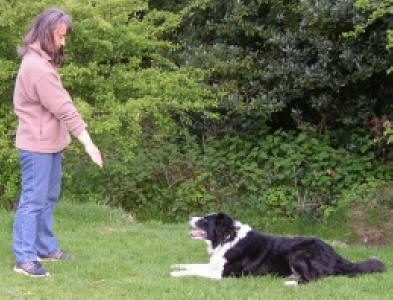 |
|
Stay or Wait: |
Full palm of hand is extended from shoulder height at arms length towards the dog. (policeman's stop signal). |
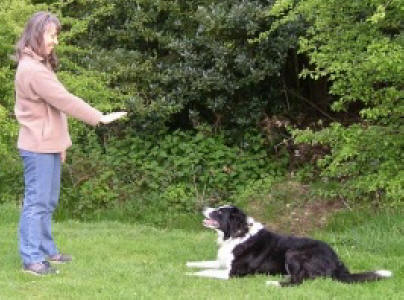 |
| Come: | Arms fully outstretched horizontally on each side then brought to meet in front of your stomach.
(Angel of the North position to those of you who are familiar). |
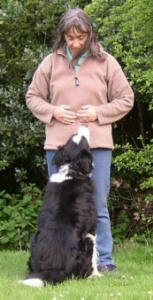 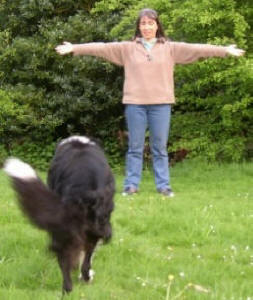 |
| Heel: | Dog walks on your left side. Tap left thigh with left hand. From front position, dog comes round your back from right side to left. From back position dog comes in on left. (on or off lead). |
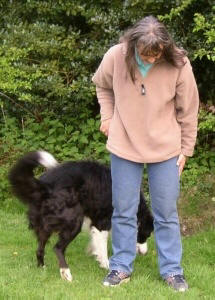 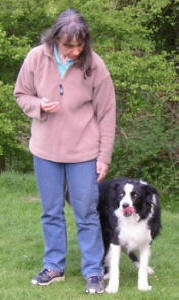  |
| Off: | To stop dog jumping up at you, say OFF as he rises to touch you and turn your back on him. Also use to get dog off a chair or other item by pointing away from item with extended arm. It is incorrect to use 'down' as it may confuse. |
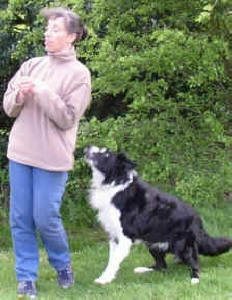 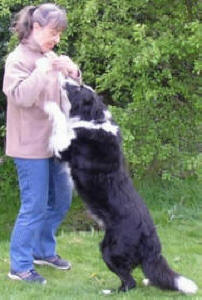 |
| Leave: | Wave hand or hands with arms extended towards the dog and away from the object you wish left alone. May be used to stop playing with toys or to interrupt feeding. |
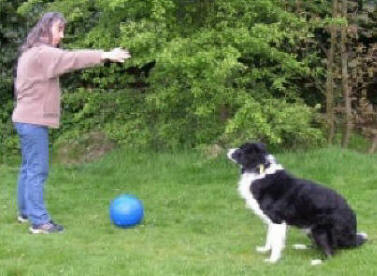 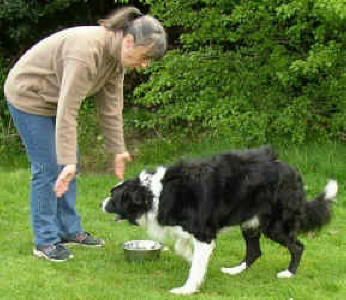 |
| Back: | Wave hand from direction of dogs head in the direction you wish him to go, hold position pointing. Repeat to get dog to go further back. To keep dog behind move extended arm backwards, palm flat and facing towards dog. |
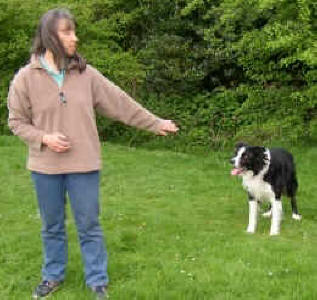 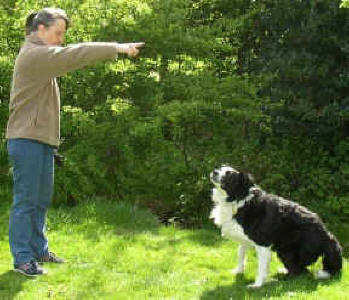 |
| Eat: | Point at food bowl, arm and index finger extended. |
 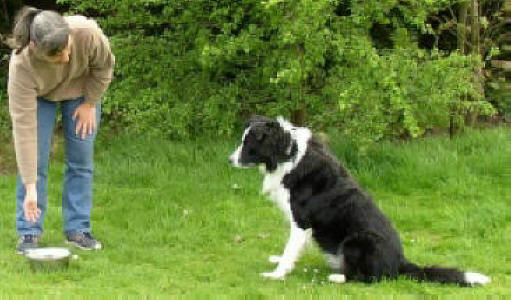 |
|
Fetch or Get It: |
Wave hand from direction of dogs head towards item to be retrieved and point. |
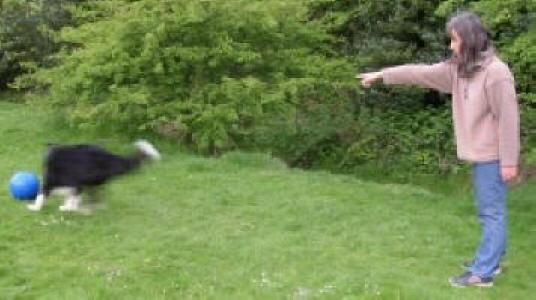  |
| Hold: | Place item in dogs mouth and place one hand palm up under the jaw and the other hand palm down over the nose, gently holding jaws tight on item. Step back and show palm of hand as in stay. |
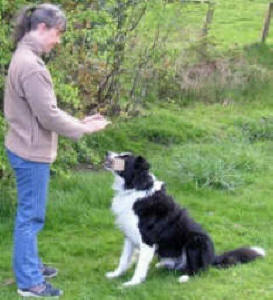 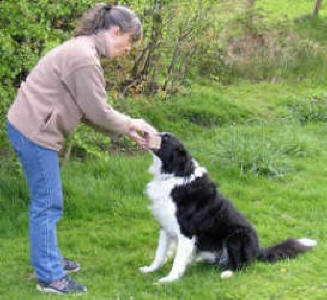 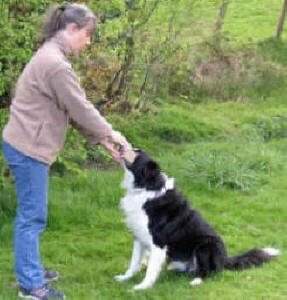 |
| Give: | Get the dog to sit first. Offer both hands to each side of the dogs mouth to take item. Grip and gently remove |
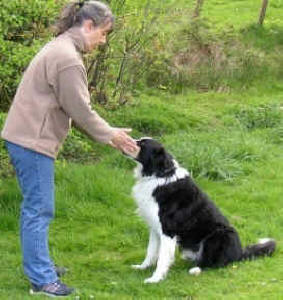  |
| Catch: | Pretend to throw with underarm 'Bowling' motion while using other arm extended and palm facing dog in 'stay' command. When you throw remove stay command to free dog to catch object. |
 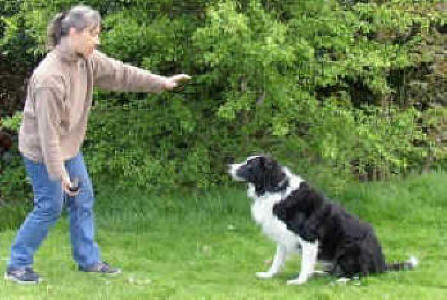 |
|
Bed: |
Point to dogs bed - this should not be used as a punishment - so smile. | Do you really need an illustration for this? More details if you click on link |
| Quiet: | Waggle extended index finger vertically, from side to side, in front of the dogs face. The hand signal used here + eye contact can be interpreted as confrontational by dominant / aggressive dogs. Use of this sign towards a dog with such problems is inadvisable and if done you can expect the dog to react as though challenged. |
Do you really need an illustration for this? More details if you click on link |
|
Wee or Poo: |
Arm pointing downward with index finger extended is moved in a circling motion clockwise motion. |
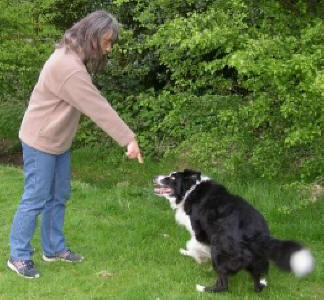 |
| Watch Me: | Point to your eyes using one or both hands until the dog makes eye contact. A very useful command to teach a deaf dog. |
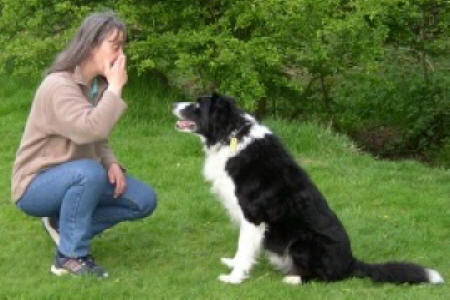 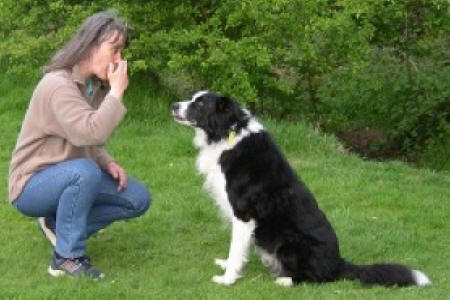 |
|
In: |
Point indoors or towards the item or vehicle you wish the dog to enter with arm and index finger fully extended. | Do you really need an illustration for this? More details if you click on link |
|
Out: |
Point outdoors or away from the item or vehicle you wish the dog to leave with arm and index finger fully extended. | Do you really need an illustration for this? More details if you click on link |
| No: | Point index finger straight at dogs head with elbow bent. The hand signal used here + eye contact can be interpreted as confrontational by dominant / aggressive dogs. Use of this sign towards a dog with such problems is inadvisable and if done you can expect the dog to react as though challenged. |
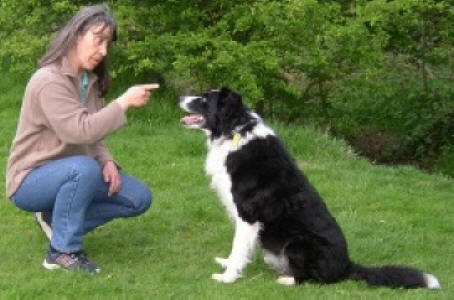 |
| Go Free: | Both arms thrown up in the air together and extended in an exuberant manner. |
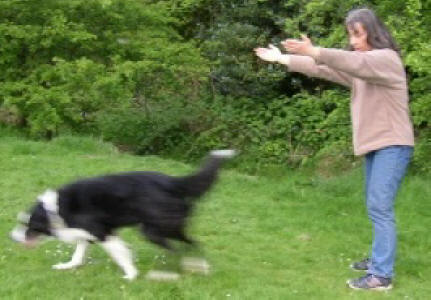 |
If you are interested in adopting a Border Collie from us,
please do not write to us or email us - we want to speak to you before we start the process.
Please phone us during office hours.
Details here.
Calls to our office and mobile will only be answered during our office hours


